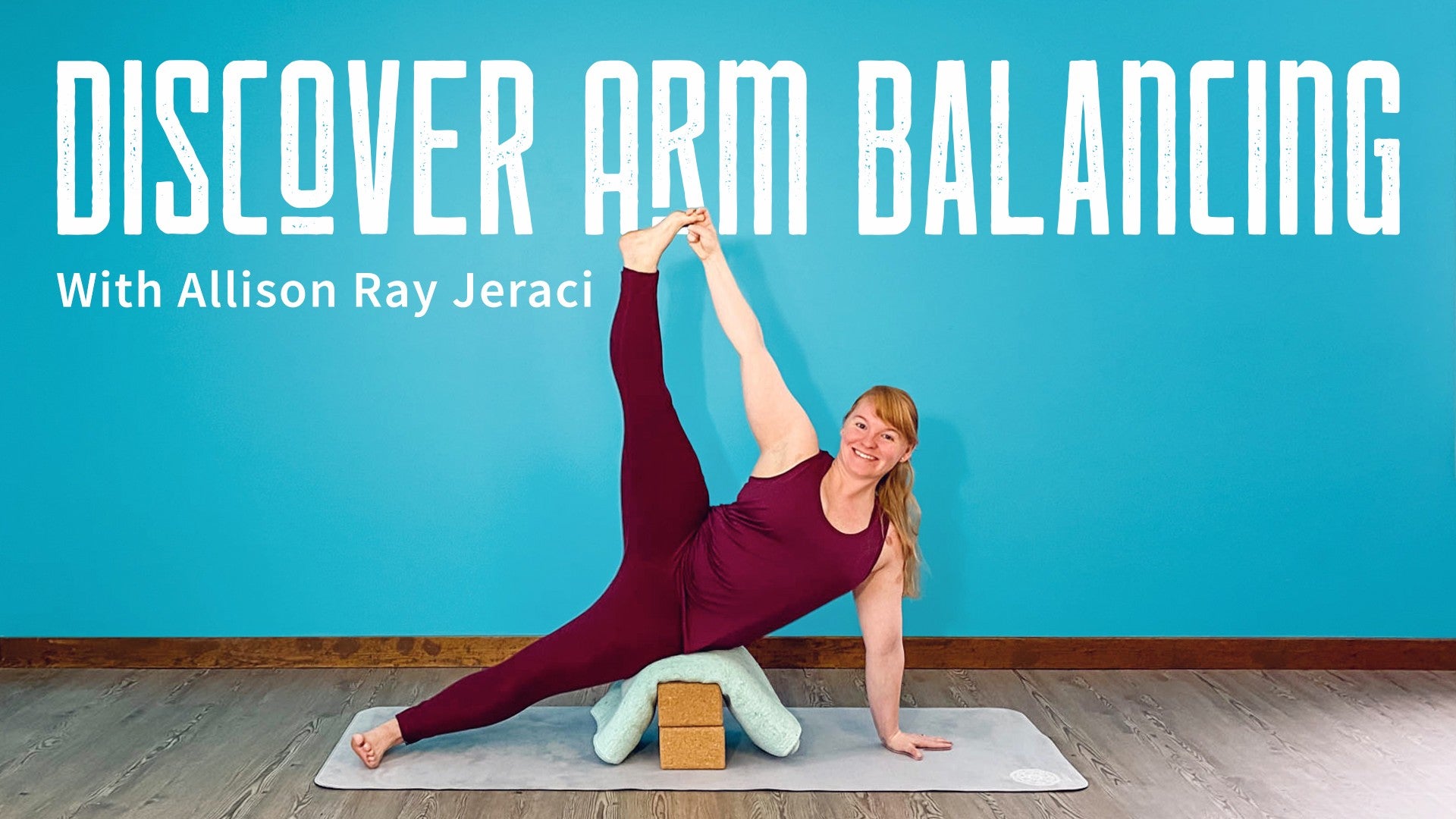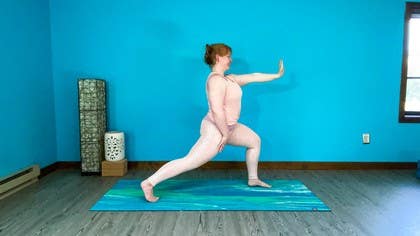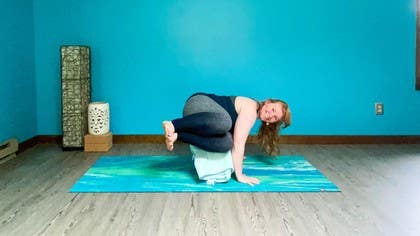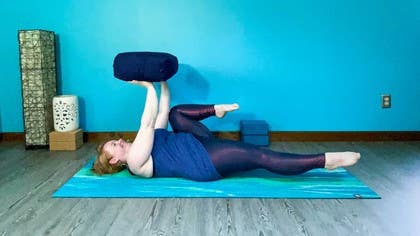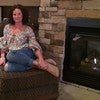Description
About This Video
Transcript
Read Full Transcript
Hi everyone, welcome back. Today we will be tiptoeing to Bakasana. So what does that mean? All throughout this season, we've been playing with Bakasana, finding propped variations, breaking it apart. And today is more of an opportunity to feel our movements and flow a little bit more. We'll be using two blocks and we'll look at the roll that the feet have in Bakasana. So if you feel like you've been preparing for Bakasana, all the pieces are there but takeoff is a little iffy right now, this might be the class for you. So we'll come down onto your back and lie in either Shavasana or constructive rest. Take your hands up towards the ceiling with your fingertips pointing up. Pull your fingertips back towards your shoulders so it's as if you were doing plank against the wall. And then curl the hands down and the fingertips down towards the floor. Do that a few more times, warming up the wrists. So we'll prepare the body but with a special focus on the feet. And then palms face away from you, tilt your thumbs in towards each other, move your thumbs away from each other, kind of like you're saying hi, but only with the palms. Okay, little circles in one direction and circle in the opposite direction. Close your fists and open and do that two more times. Good. Release your hands. Draw your right knee in towards your chest. So think of that compact shape of Bakasana. Point your toes. With your left thigh, reach your left leg forward. Take the left hand to the top of the left thigh. Take your right palm to the middle of your right thigh and push your thigh away from you with resistance. So you're pulling your thigh into the palm of your hand as you're pushing the leg forward. Press, press, press, press, press. Keeping your left thigh grounded, remove your right palm and see if you can draw the right thigh a little bit closer to the chest. Then press, press, press, press, press. As you lift your right thigh, you'll guide it more towards the outer ribs rather than to the center or towards your midline. Keep driving your thigh into the palm of your hand. Release and lift the thigh up a little bit higher. Hold there. It's a lot of work. It doesn't seem like it's much, but it really is. Okay. Now keeping this compact shape, flex your right foot and point. Flex and point. Flex and point. Good. From here, very softly place the right sole of the foot onto the floor, but feel how your foot makes contact. Which part of your foot makes contact with the floor first? Okay. And then feel the amount of pressure that you place on your foot as you start to draw the left leg in, placing the left foot softly onto the mat. Okay. From here, left knee comes in towards your chest. Right leg extends forward. Point your left toes. Left palm to the left thigh, right hand right to the root of your right thigh. Press the right palm down. Press your left palm forward. Drive your left thigh into the palm of your hand. Take another breath there and then lift the left palm. Draw the left thigh a little bit closer. Okay. It's going to be hard because you're already kind of at your max of drawing the thigh in. Push the left thigh. Resist. So the left hip flexor is working a lot in a shortened position to try to become even more compact. But you're generating muscular force in this position. Press the left palm forward. Left thigh into the palm. Press, press, press. Okay. Lift the hand. Draw in a little bit closer. Point and flex the left toes. Good. And then from here, place the left sole of the foot very softly down onto the floor. So no weight on the foot. 1% of weight on the foot. 50%. And all of the weight of the foot rests on the floor. Lift your right knee up. Place the right foot softly onto the mat and perceive, right? We can't see where our feet are, just like in Bakasana.
Feel their contact. More contact. And then feel the full sole of the foot against the floor. Lift your toes. Spread them apart. Feel them make contact with your mat. Grip your toes and release. Grip the toes and release. Good. Roll on over to your side and make your way onto all fours for tabletop. And in this tabletop, have your hands about shoulder-width apart. Press your finger pads deeply into the mat. Shift forward and back some. So again, moving into the arena of the wrists. And once your shoulders come right on top of your wrists, do a little lateral movement. Feeling the weight shift onto the pinky fingers. Passing to the thumbs on the respective sides. And back through center. Good. Grip your hands. Now lift your chest forward and up into cow. Exhale, round the spine into cat. Inhale forward and up into your cow pose. And exhale, round into cat. As you round, spread the shoulder blades like Bakasana. Spread the middle back, the lower back. Come back into cow. So you can take this one step further and add super cat to the sequence. So inhale into cow. Exhale cat. Then there's a little extra exhalation where you press down through the tops of your feet and hover your knees away from the floor, maintaining the rounding of your spine. Okay, then lower the knees back down. Inhale into cow. Exhale cat. At the end of your exhalation, a little extra exhalation into super cat. Okay, and I'm doing this with the toes pressing down into the mat, but certainly if that's not accessible, you can tuck the toes under and hover your knees away from the floor. So both options work very well. And come into that last cat or super cat. And tops of the feet to the ground, wherever you are, move your knees slightly towards the outer edges of the mat. Slide your hands forward in the buttocks back for child's pose. Take a few breaths here in child's pose. And be aware of the shape of Bakasana. The hips are deeply flexed. Knees are deeply flexed. Maybe there's some contact between the feet. Maybe your big toes are touching. Maybe more of the foot is touching. And from here, we'll come into a lateral child's pose. So walk your hands over to the right. Keep pulling the left outer buttock back away from your left hand and rest your forehead. Feel the left side of the body lengthen as you breathe. Walk your hands back through center and over to the left. And the same thing here. Pull your right outer hip back as you encourage your right fingertips to elongate forward. And noticing the space all along the right side of your body. Now walk your hands back through center. Pull the hands back so they're about shoulder width apart and face your knees forward. Walk your hands four to six inches out in front of you so that the wrists are well in front of your shoulders. Grip into the floor. Tuck your toes under. Then from here, bend your elbows. Bend them out to the sides so that there's this pushing action that will occur. Elbows bend, toes tuck under, and then hover your knees away from the floor. Try to stay low as you straighten the arms. So I'm not straightening my legs. My elbows stay bent. My knees stay bent. And then when I go to straighten my elbows, my buttocks reaches back towards the short edge of my mat. Take another breath there. It's a lot on the front of the thighs. Then as you exhale, rest the knees down and pause. So that just gets us to feel that pushing action that we want to feel when we come into bhakasana. Okay, we'll do it one more time. So bend the elbows. Hover the knees. Keep the knees bent. Push into the hands, buttocks back. And now from there, keeping the flexion of your hips, that deep bend at the hips, start to unravel the backs of your legs. From here, slowly pedal really slowly, okay? So drop your right heel down. Lift your left heel up. Then feel the shift of the weight as you start to pick the right heel up and press the left heel down. And then we might exaggerate this motion even more. So as I drop my right heel down, I feel less weight on the ball of the left foot, transfers into the toes. And then maybe I start to lift up onto that big toe and reverse. I gradually give more weight over onto the left toes, left ball of the foot. The left heel starts to come down as the right heel peels up and less weight on the ball of the right foot, less weight on the toes, right up onto that big toe and reverse. You'll also notice that as you're shifting weight, there might be a tendency to kind of lean forward into the shoulders as if you were to approach plank. But try not to do that and feel the action of the thigh coming towards the torso.
Switch again. So the more you lift up onto the ball of the foot or onto the toe, the deeper the thigh roots into the chest or into the side body. One more. Good. And then from here, let's walk your feet up towards your hands. You can walk your hands back towards your feet and also support. So lift the height of the floor up into the palms of your hands for Uttanasana. Bend your knees, look forward. So buttocks back, deep knee bent. You start to drive the knees forward towards your arms and fold forward. One more time, buttocks back, knees come forward towards your arms, connecting the lower and upper body and fold. Good. Press your blocks forward. Take your hands to your hips, a little bend of the knees. Walk your chest forward and come all the way up to stand in Uttanasana. Feel the soles of your feet on the floor. So connecting with the balls of your feet, the big toe mound, that fleshy path underneath your big toes, the little toe mounds towards the outer feet, your heels, the space beneath the arches of your feet, your toes. And then can you grip your toes a little bit? Scrunch them up and then stretch them forward. Scrunch a little bit and stretch them forward. Find your unique foot placement for your Uttanasana. Now we'll find that shift of weight. So assuming our weight is 50-50 between the heels and the balls of the feet, make the heels lighter so the balls of the feet and the toes become more active and heavier against the mat. Lift the heels up. The ankles might do a little dance. It's okay. And then very slowly, notice just how much awareness you're using in this moment. As your heels descend and you start to feel more of the foot make contact with the mat, the skin of your foot making contact, then you might rock back a little bit, sharing more weight into the heels. Toes light. Maybe there's no weight on the toes. And you rock forward again. The ball mounds press down. Skin of the toes makes contact. Heels lift up and then slowly reverse. So that in a sense, your brain, your mind is 90% in your feet. You're controlling the movement and the shifting of the weight so that you don't need your eyes to help you do this movement. So the idea of proprioception. Good. And then slowly lower the heels back down. You might notice that your toes act as brakes. It's pretty cool. So from here, sit your hips back. Take your hands to your outer thighs. Press your thighs into your hands. Push your hands back into your thighs as you bend your knees. Your knees are about over your third toes. Okay. That's the direction in which they're pointing. Press press press press press. Then from here, fold forward. Take your palms to your blocks.
Step your right foot back. You make any adjustments you need for this lunge. From here, similar to what we did at the beginning of the practice, come on up. This back leg can be bent or straight. Take your right palm to the root of your thigh, left hand to the top of your left thigh and a little bit of traction. So you're going to press your left palm forward. Press your right palm back. And now keep the right palm pressing back as you reach your left hand forward like bakasana. Pull the fingertips back towards the shoulder. On an exhalation, release your hands down to your blocks. Okay. And then feel the shift, right, as you come forward. So a little more weight on the ball of the foot, less weight on the ball of the foot. You might step a couple of times, but if you do feel each time, the foot makes contact with the mat until you step all the way forward. And inhale, bend the knees, look forward. Press the knees slightly out. Step your left foot back. Okay. Find your lunge position. Pull the chest forward. Slowly come on up. Take the right palm to the top of your right thigh. Take the left hand to the top of the left thigh. Press the right palm down. Press it slightly forward. Left palm straight back. Reach your right arm out in front of you. Shoulder height. Pull the fingertips back. Feel the weight in the ball of your left foot.
Okay. And watch it change as you now lower your hands down to your blocks. Shift forward. The foot gets lighter. Okay. Maybe you come onto the top of the foot, drag the foot forward or step it forward. Inhale, bend your knees, look forward. Exhale, step your right leg back. Lower the right knee to the floor. Exaggerate here. Point your right toes. And with control, slowly lower the right foot down and feel how the top of your foot makes contact with the mat. Right? Did the foot sort of slam down to the floor? Was it a smooth action? Was it jagged? Okay. And take your hands to the top of your left thigh and pulse in and out of your lunge. Okay. And then if the feet are too far apart, you might not be able to benefit by bending your knee well past your ankle. And I know that might be something that we don't always say to do, but it's okay. Right? We want to encourage this sense of dorsiflexion. Okay. And it's beneficial for bakasana, especially in the entry because we were looking at a deep ankle flexion in that moment. And you are controlling how far you go forward. So feel as you approach it. Okay. And then the next time you bend your left knee, lift your arms up. You can butterfly the hands, hooking the thumbs. Side bend over to the left. Press the top of your right foot strongly into the mat. Nose the reaction at the front of your right hip. Okay. Inhale back up. Release your hands to your blocks. Tuck your right toes under. Feel how the toes may contact with the mat. When the balls of your feet may contact with the mat and your knee lifts, reach the chest forward. And then sense less foot on the ball of the foot, less weight on the toes. Step the right foot forward. Inhale. Bend your knees. Look forward. Step your left foot back. Lower the left knee down. Okay. Exaggerate. Point the left toes. Slowly, as smoothly as possible, lower the left top of the foot to the floor. Feel how it makes contact. What parts of the top of your foot make contact? Can you feel which toes make contact with the floor? Okay. And then from there, come on up a little bit and rock forward and back. If you feel like you can bend your right knee more, you might walk the foot back a little bit to allow for that to happen. What I'm not asking is for there to be a space here underneath the heel. Okay. So you're bending your right knee, bending at the ankle, only to which the heel allows you to stay there. So the heel isn't lifting away from the floor as you come forward. Okay.
And then the next time you bend the right knee, you can stay in this position back out or change the position of your right foot. Okay. Lift your arms. Press the top of your left foot down. Exhale, side bend over to the right. Press your left foot strongly into the mat as you breathe along the left side body, similar to your lateral child's pose. Inhale on up. Exhale, release your hands. Okay. Feel the left foot. Tuck your toes under. Feel how the toes make contact. When the ball of your foot makes contact, lift your knee, right? Maybe more of the ball of the foot then makes contact with the mat. Then the shift. Ball of the foot gets lighter, toes get lighter, left foot steps forward. And there you are in Uttanasana. Inhale, bend your knees, look forward, step your right foot back. Okay. Have your blocks on the tallest height and I'm going to smidge my left foot back a little bit. So maybe it's not as long of a lunge. And with my right foot, I pull my right heel back and then I shift forward. I can walk my hands forward, my blocks forward. So they come onto the right big toe, maybe like the nail of the toe. And then I walk back. Okay. So you'll shift forward and back. So you do have a little more dorsiflexion happening in that front ankle, but your awareness really is on the back foot. Ball of the foot, toes, big toe, big toe, nail, whatever it may be. As you reach the right heel back, imagine the right heel is being pulled by a string. So it elongates the arch of your foot. Okay. Then the next time you roll forward, feel when that big toe gets so light that you can lift the right leg away and come into a hands down supported warrior three. Point your toes.
Lower your right foot next to your left. Bend your knees. Step your left foot back. Feel the left toes as they make contact. The ball of the foot as it makes contact. Reach back through your left heel and reverse. Push through the ball of the foot while the foot gets lighter. Toes get lighter. Big toe support. Okay. I'm going to shorten my stance a little bit so you might shorten or elongate your stance depending as this very melodic rolling action happening at the foot. And if you think about your arm balance, isn't this that shifting process? Okay. You're on your feet or on the balls of the feet. Get lighter, lighter, big toe, and then very light. And then there's take off. Okay. So let's practice that take off here. Weight in the ball of the foot. Less weight in the toes. On the big toe, lift the big toe up. Point the left toes. Supported warrior three. Good. And then from there, release your left leg next to your right. Okay. Open up your feet so that there's space between them. Take your hands to your hips. A little bend of the knees. Pull the hips back. Inhale on up to stand. Okay. Now we're going to practice a little bit of squatting. So from these squats, before we were in Tadasana, we lifted up onto the balls of the feet and lowered the heels. Very similar. So you'll lift the balls of the, uh, you'll lift the heels up. Then from there, bend your knees, bend your hips. So the buttocks back. Okay. And then straight in. And then anytime you can lower your heels to the floor. Okay. Each time you bend your knees, you see, well, can I bend my knees a little bit more and my hips a little bit more. Straight in. Rest. Heels lift. Knees bend, buttocks back. Okay. And then you might go a little bit lower and then press back up. Feel the heels as they make contact with the floor. Lift the heels. Feel more weight come into the balls of your feet. Bend your knees, bend your hips. Maybe there's some contact between arms and legs, upper body and lower body. And then rise back up. Feel the shift of weight. Heels make contact.
Okay. One more. Rise up. Squat down. Maybe some contact. Lift back up. Perceive. Feel as your heels lower to the mat. Shift your weight back into your heels. Soften your toes. Let them lift, spread and then rest. Take your hands to your hips. Bend your knees. Shift forward. Come into Uttanasana. Support your hands. Okay. I'm going to support my forearms. Place two blocks on top of each other and then release the head. You could do this on a chair, a higher surface to meet you where you're at. Good. Okay. From here place your blocks aside. Hands to your hips. Come on up. Okay. Are we ready? Okay. We're going to try our Bakasana with our mind and our feet. So for this particular Bakasana, you don't even have to think about lifting the feet, but think about the actions of the feet. Okay. So start with your feet together. The knees will come out to the sides. You'll lift onto the balls of your feet as you descend. Okay. Walk your hands forward. Very Bakasana esque in this Malasana squat. Okay. Reach the size of the body forward. So maybe you can wiggle your ribs forward some, buttocks back. So think of child's pose. All the actions and cueing of child's pose helps very much in this variation. Okay. Then from there, keep your hips back. Pull your hands back. So your forearms come down towards the floor, almost like a sphinx. Okay. Then from there, your body is shifted back. Eventually we're going to shift forward. So pull your arms back so that they may contact with your shins slash knees somewhere in that area. Okay. It's all useful and works. Now there's a connection here. Keep this connection between the arms and the thigh in the shins. Hands come down. First lifts a little bit. Okay. And the buttocks is lifting so that you can shift forward, look forward and then rock back. Okay. Heels might be touching or still hovering. Mine are hovering. Okay. But I feel the weight on the balls of my feet. Then they get lighter. Then my toes get lighter. Then I feel myself on my big toes and it's okay because I felt that already in my practice. Okay. And then I shift back. Feel the weight in the toes and the balls of the feet and perhaps in the heels. You'll do that a few times. Rock forward.
All of your focus on your feet as you look forward. And then rock back. And then shift forward, rock forward. Maybe the balls of the feet get even lighter. The big toes, the nails are scratching your mat. And then back. Okay. Forward fold. Straighten the legs. Drop the heels. Separate the feet and release. Take a few breaths there. You can walk your hands over a little bit to the right. Some lateral movements. Walk over to the left. Back through center. Okay. We're going to do it again. Okay. This time. Okay. So the heels will be close or on the floor. You'll roll into the ball of the foot, into the toes. Then think that you're pointing your feet. Okay. And you'll point your big toes and see what happens. Okay. So feet together. Knees apart. Squat down. Walk the hands forward. Buttocks back. Elongate through the sides of your body. Wiggle the ribs forward. Hands come down. Slide. Drag them back. So that the arms make contact with the legs. Okay. Then from there, you lift the hips a little bit and that might help you to tuck the arms under even more. Then from there, shift forward. Look forward. Feel the weight on the balls of the feet. To the toes. Big toes. Point your feet. And then back to the mat. Okay.
Balls of the feet are making contact. Toes make contact. Big toes make contact. Point your feet. And back. How'd you do? Okay. All right. So we're gonna do it one more time. Let's rest again. Straighten your legs. Move the feet apart. You can slip your hands underneath your feet or pull your blocks over on any height. Put your fingertips towards your legs and your palms up towards your underarms. Okay. So your feet don't have to come all the way up to your buttocks right to begin with. Okay. But now maybe you felt a little bit closer taste of flight. So this next round, keep playing with pointing your toes. Right. Thinking about what's it like to shift my weight onto my hands and point my toes. Okay. And if that's coming along, then, right, you'll point your toes and then proceed to lift your heels towards your buttocks. Okay. Let's give it a, let's give it a try. Place your blocks aside if you were using them. Bring the feet together. Knees out to the sides. Walk the hands forward, buttocks back. Palms down. Drag the hands back. Make contact between upper and lower body. Okay. Balls of the feet are making contact. Then they lift. Then you feel the toes get lighter. Balls of the feet get lighter. Point your toes. If that's going well, don't shift forward. Look forward, but don't move forward with your chest. Heels up towards the buttocks. Okay. Then feel as your big toes make contact. Then your toes make contact. Balls of the feet contact. Maybe the heels make contact. One more time. Hands to the floor. Shift forward. Less weight on the balls of the feet. Less weight on the toes. Less weight on the big toes. Point. Pull the heels up. All right. And then toes come down and that's over. All right. So I hope you felt a little taste of that, but look awesome in flight. Let's roll on over to our backs. Bring your arms out to the side. Stretch them out to a T position and then roll your upper arms in and out. So the palms face down and then the backs of the hands come to the mat and you might roll over a little bit more. So the thumbs make contact like a slinky almost. Okay. And then the palms start to reach behind you like the pinky fingers are trying to reach the floor. And then arms back down, backs of the hands down to the floor, palms to the floor. Let the shoulders roll in and the shoulders roll out a few times. Good. And then release the arms. Press your feet down. Move your hips over towards the right side of your mat. Some lift the knees in towards your chest and bring the knees down to the left. You can look up at the ceiling or turn your head to face your right hand.
And then from there, slowly bring your head back to center, bring your feet to center and your hips. Okay. Take your fingertips, pull your fingertips towards the underneath of your forearms. Bend your elbows so the fingertips come towards your shoulders, your upper arms. And reverse the action. Keep the fingertips pulling in as the forearms come to the floor and the hands soften. Curl in. Then bend the elbows. And release. Elbows straight in and then the hands release and soften. Okay. Press your feet down. Lift your hips up. Move them over towards the left long edge of the mat. Draw your knees in and up towards your chest and down to the right. And then if that's comfortable, you can start to turn your head to the left. And let the body be soft, especially the shoulders and the arms. Let your feet relax. They've done a lot of thinking power throughout this practice. And bring your head back to center, feet to center, hips to center. Okay. And again with the fingertips, curl them in towards the forearms. Pause. Bend the elbows. Maybe make contact. Keep pulling the hands under as you straighten the elbows and then release the hands. Hands come in. Elbows stay straight. Then they bend. Contact. Curl the fingers in as you straighten your elbows and then release the fingertips. Pull out over your blocks. You might use one or two depending on how much surface area you want to use or how high you want the blocks to be. I'm going to go for the middle height with my blocks stacked, one on top of the other like this. So they're both on their lowest height and horizontally positioned. And they come right to the top band of your buttock flesh so that the rest of your buttock flesh can rest on the blocks. And then once that's feeling secure, you want to also feel, make sure that your blocks are stacked one on top of the other. Then from there, rest your arms. You can roll one shoulder under, roll the other shoulder under for this bridge pose. So it gives you a little passive extension of your shoulders. Throughout this arm balance and the predominant structure of the class, your shoulders have been in flexion. So now they come softly behind the body. And then check in with your hips and just be aware if there is still sort of a crease at the hips or if that crease is flat and out. So you're coming into passive hip extension. And then you might explore walking your feet forward and feeling their journey as the heels make contact, the balls of the feet make contacts.
I scrunch my toes to walk my feet forward. But you might not. You might move in a different manner. The legs do not have to be straight all the way. So the sensation resides in the front of your hips after all that compactness that we experienced in Bakasana. And let your breath be soft, smooth, and deep. Let the soles of your feet rest against the mat, noticing the parts of your feet that feel heavy, the parts that feel light, where you hold a lot of awareness. And then slowly start to walk your feet back, paying attention to how they move, how you feel the shift of weight, feeling the texture of the mat underneath the soles of your feet. And once you've bent both of your knees, feel the heels that they're able to drive straight down into the floor. When you get to that point, drive them down, lift the hips up, slowly remove your blocks from underneath your hips, move them aside, and slow your descent down to the floor. Okay, release the shoulders, your spine come back to neutral. And pull your left knee in towards your chest, give yourself a little hug. Release the left foot, feel as the skin of the foot makes contact with the floor, so slowing that process down. And then draw the right knee in towards your chest. And feel as the skin of the right foot makes contact, how the foot makes contact. And now feel as you lift both of your feet symmetrically away from the floor, hug the legs in, and slowly release the feet, again feeling how they make contact. Okay, now let your feet breathe in Shavasana as you straighten your legs. If you find that your blocks are in your way, move them aside and make any adjustments that you need for your Shavasana. Separate the backs of your teeth, releasing your jaw, and allow your body to naturally unfold. Shavasana. And you're welcome to rest here for as long as you'd like to. And you're welcome to rest here for as long as you'd like, otherwise wiggle your fingertips and your toes, twinkle them about. Okay, then bend your knees, feel your feet as they make contact, roll to one side, and very slowly press yourself up to any comfortable seated position. And soften your eyes, join your hands together in front of your heart, touch your heart to uplift it. Om Shanti Hee, Shanti Hee, Shanti Hee. Om Peace, Peace, Peace.
Thank you for joining me, and I'll see you next time.
Discover Arm Balancing: Bakasana & Family
Comments
You need to be a subscriber to post a comment.
Please Log In or Create an Account to start your free trial.
